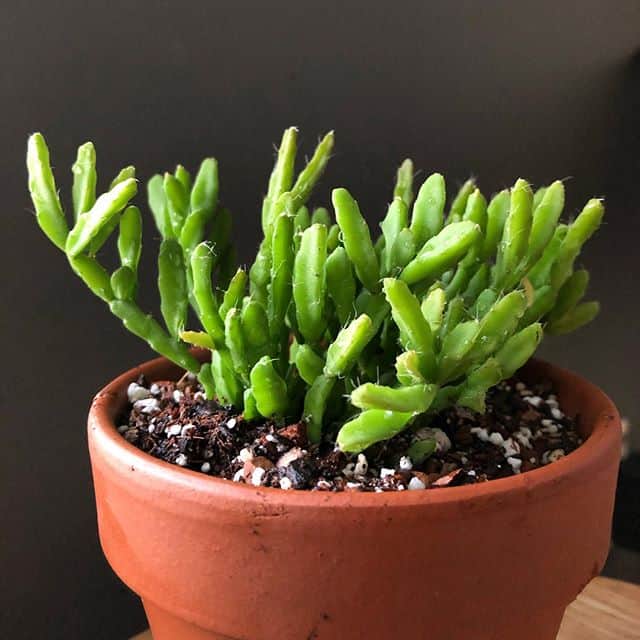Rhipsalis ewaldiana are very decorative hanging crass plants.
Rhipsalis belong to the cactus family and stand out for the striking vegetable waterfalls that they are capable of creating.
Most varieties of rhipsalis are very undemanding plants in terms of their care since they do not need many water and a couple of times a week will be enough.
In addition, they need to be in a somewhat bleak place, or at least not be directly sunburned.
If they are affected by the sun’s rays, or if they have a very long exposure, the plant will need more water and they will also change the green color of the stems to a brown color.
If we keep the plant in a shady place, the green color will sharpen.
One of the characteristics that attract the most attention is the leaves or stems.
In many of the varieties, the leaves or stems have a cylindrical shape and even resemble the branches of a tree.
As for flowering, they tend to have an insignificant flowering, and they have the appeal to see how they are branching and creating the vegetable shade.
You may like oreocereus celsianus
Tips to take care of the Rhipsalis ewaldiana “Mistletoe Cactus”
Temperature
The plant is most often found indoors and may simply be mounted on a piece of bark like an orchid or potted in a good cactus mix.
If you are not prone to overwatering, you can plant the cactus in regular potting soil mixed with sand or other gritty material.
The plant is used to living in the understory of the forest, where temperatures are at least 60 F. (15 C.) and light is filtered through the high limbs.
Growing Rhipsalis is practically foolproof as long as you mimic its native conditions.
Propagation
Rhipsalis ewaldiana “Mistletoe Cacti” is easy to grow from cuttings.
Seeds take way too long and they require very even environmental conditions.
Take cuttings and let the severed end callus for a few days.
Plant the callused end in a cactus mix or sand that has been lightly moistened. Cuttings root in two to six weeks.
Seeds can be started indoors in flats filled with sand and peat.
Moisten the medium and plant the seeds 1/4-inch deep. Keep the medium barely moist until the plants germinate.
Grow young plants in semi-shade and water when the surface of the soil is dry.
Watering
Ensure that your mistletoe cactus is planted in well-drained soil.
Potted plants benefit from a saucer filled with rocks and water to increase the ambient humidity in the home interior.
The plant rarely needs fertilizing and has few other needs except moderate light and even moisture.
Fertilize with a half dilution of cactus food from April to September, once per month. Water frequently in spring and summer, but suspend water in winter.
If any of the stems are damaged, you can trim them off with a sharp, sterile knife. Use these as cuttings to start new Rhipsalis mistletoe cactus.
Conclusion
Rhipsalis ewaldiana “Mistletoe Cactus” is the perfect addition to your hanging baskets, especially in areas of your home or garden that doesn’t receive a lot of light.
It does best when planted in a terra cotta or clay pot.
In its native jungle growing habitats of South America, Rhipsalis ewaldiana received filtered light through tree branches.
Keep this in mind when choosing where to plant your “Mistletoe Cactus.”
It belongs to the Cactaceae family.
The most common species are: Rhipsalis cassutha, Rhipsalis oblonga, Rhipsalis pilocarpa, Rhipsalis puniceodiscus, Rhipsalis burchellii, Rhipsalis rosea. They come from Brazil, from the rain forests. It is commonly known as Ripsalis.
They form small epiphytic shrubs with flattened stems that eventually become round.
The flowers appear at the ends of the stems and are pink or red. It blooms in spring and the flowers last about two months.
The minimum temperature they support is 10 ° C. It must be located in semi-shade throughout the year.
As soon as the first yolks begin to emerge, the temperature must be increased.
The earth must always be wet.
The earth must be rich in humus and with 1/3 pieces of bark. It does not support lime.
Transplants, if necessary, should be done after flowering.
During the period of growth, you should be given the irrigation with a special fertilizer for cacti mixed with the water every 15 days.
It can be placed on the terrace, or in a hanging pot in the living room. It can also be planted in hydroponics for indoor plants.
During the summer, if the air is too dry, it can be attacked by the red spider or the cottony mealybugs. Maintain high humidity.
The Rhipsalis ewaldiana take root easily if they are cut in May or June and planted in peat at about 22 ° C
